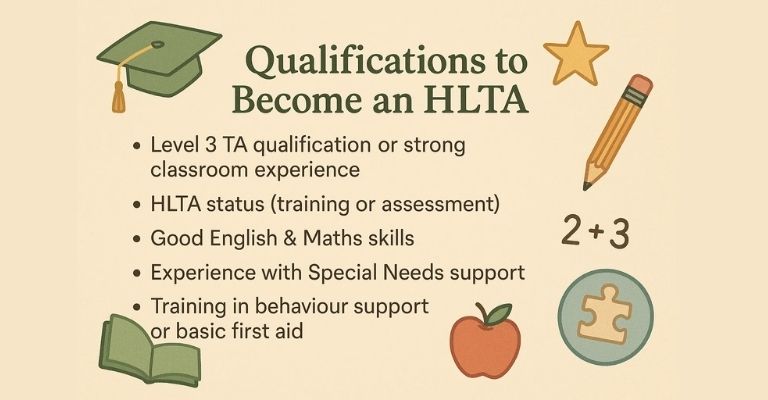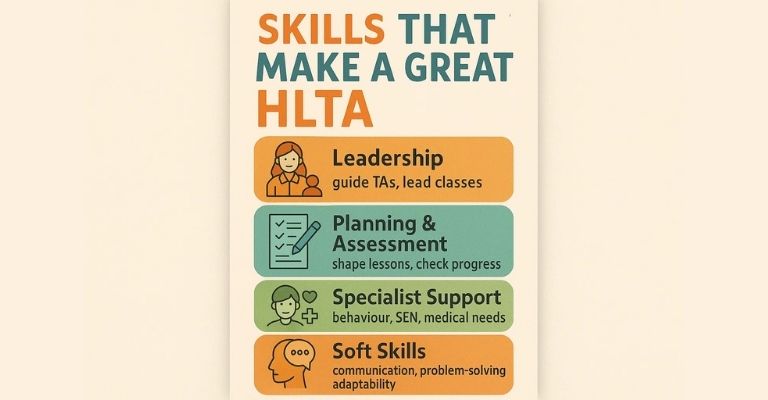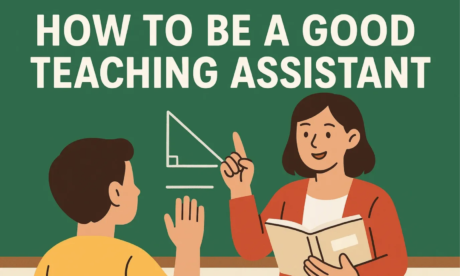What is a higher level teaching assistant? It’s a teaching assistant who takes on extra responsibilities and plays a bigger role in school life. They might lead lessons when the teacher is away, help plan classroom activities, or support children with different learning needs. Many also guide new teaching assistants and keep the classroom running smoothly.
This role sits between a teaching assistant and a teacher. It gives more trust, more pride, and more chances to make a difference every single day. If you love supporting children, enjoy taking the lead, and want to grow in your career, becoming an HLTA could be the step you’ve been waiting for.
In this article, you’ll learn what an HLTA does, how the role is different from a regular teaching assistant, and why schools value them so highly. We’ll also look at the training you need, the pay you can expect, and the career opportunities that come with the role. By the end, you’ll have a clear picture of the HLTA position and whether it could be the right step for you.
What Is a Higher Level Teaching Assistant and What Do They Do in Schools?
A Higher Level Teaching Assistant (HLTA) does much more than just help in the classroom. They often step in to cover whole classes when the teacher is away, making sure lessons still run smoothly. This means children don’t miss out on learning, and the school day keeps its flow.
But that’s only part of the picture. HLTAs also plan lessons, lead small groups, and give students one-to-one help when they need it most. They often support marking, feedback, and assessments, which makes teachers’ workloads lighter and keeps everything on track. On top of that, HLTAs guide other teaching assistants, share good practice, and mentor less experienced staff. They play a key role in behaviour management and often support children with special educational needs. This takes patience, kindness, and a calm approach.
Most importantly, being an HLTA is about making a real difference every single day. It’s about giving students confidence, creating a safe space to learn, and being the person who can step up when things get busy. And at the end of the day, many HLTAs say the pride they feel in helping children grow makes all the hard work worth it.
What Qualifications Do You Need to Become an HLTA?

To become an HLTA, you usually need a strong background as a teaching assistant. Many schools prefer a Level 3 TA qualification or the same amount of classroom experience. This shows you already understand school life and how to support children.
On top of that, HLTA status is often required. You can gain this through a training programme or an assessment route. It’s proof that you’re ready to take on extra responsibility.
Here are some of the key things schools often look for:
- Level 3 TA qualification or good classroom experience
- HLTA status through training or assessment
- Good English and maths skills
- Experience supporting children with special needs
- Training in behaviour support or basic first aid
Each step helps you grow more confident. And in the end, it feels amazing to take on a role where you can truly make a difference.
How Much Does a Higher Level Teaching Assistant Earn in the UK?
So, how much does a higher-level teaching assistant earn in the UK? Most HLTAs earn between £23,000 and £30,000 a year. That’s a big step up from a regular TA role and shows how schools value this position. The DfE’s School Workforce Guide 2025 mentions that “HLTA status” is a data element tracked in school workforce data. GOV.UK
What HLTAs Can Expect to Earn
Here are some key points to give you a clear picture:
- Typical range: £23,000 – £30,000 per year
- Experienced HLTAs often earn £29,000 or more
- Full-time adverts: £28,598 – £30,024 listed on Teaching Vacancies
- Local council scales: Wigan Council shows £27,334 – £30,296 (Grade 6)
- Special schools: some contracts go up to £33,945
As you can see, the pay reflects the extra responsibility and trust that come with the role. And beyond the money, there’s the pride of knowing you play a vital part in children’s education. That feeling is worth just as much as the payslip at the end of the month.
If you’re considering this path, you might also want to explore how to become a teaching assistant.
What Skills Make a Great HLTA (and Help Justify Pay)?

Think about the best HLTAs you’ve met or seen. They’re the ones who walk into a classroom and instantly bring calm and order. They’re also the people who give teachers peace of mind, because they know the class is in safe hands.
To stand out in this role, you need a strong mix of skills:
- Leadership – guiding other teaching assistants and leading classes when the teacher is away
- Planning and assessment – shaping lessons and checking how well children are learning
- Specialist support – helping with behaviour, supporting children with special needs, or handling basic medical needs
- Every day, soft skills – clear communication, problem-solving, and the flexibility to adapt when things change
When you bring these skills together, you become more than just support — you become a backbone of the classroom. And that’s exactly why schools recognise HLTAs with higher pay and deeper trust.
Pros and Cons of Being an HLTA
Like any job, being an HLTA comes with its highs and lows. It’s good to look at both sides before deciding if the role is right for you.
Pros
- You earn more pay than a standard teaching assistant.
- You get greater influence in the classroom and more responsibility.
- Your days feel more varied, with opportunities to lead, plan, and support children in new ways.
Cons
- The workload is heavier, and you’ll often find yourself juggling tasks.
- There are higher expectations, and you need to be ready for more accountability.
- The pay, while higher than that of a TA, is still not equal to that of a fully qualified teacher.
Even with the challenges, many HLTAs say the pride and fulfilment make it worthwhile. After all, you’re trusted with real responsibility and the chance to make a lasting impact on children’s lives.
Career Progression After HLTA

Becoming a Higher Level Teaching Assistant (HLTA) doesn’t have to be the end of your journey. For many, it’s just the start of something bigger.
Some HLTAs move into roles like SENCO (Special Educational Needs Coordinator), Inclusion Lead, or even school leadership. These positions let you use your classroom experience to shape how schools support children and staff. You become part of key decisions that make a lasting impact.
Others see HLTA status as a stepping stone into teaching. With the right training, you can qualify as a teacher, take on your own class, and enjoy the full rewards of teaching. Many HLTAs find the transition easier because they already know how schools run and what students need.
There are also chances to specialise further. Some HLTAs focus on behaviour support, safeguarding, or working with children with complex needs. These skills are in high demand and can help you stand out when applying for new roles.
And of course, with each step forward, the salary grows too. More responsibility usually brings more recognition and higher pay. But beyond money, there’s something even more valuable—the pride of knowing you are growing, making a difference, and becoming a true leader in education.
How to Apply for HLTA Roles
If you’re ready to take the next step, applying for an HLTA role is simpler than you might think. The first place to look is school websites, local council job boards, and education recruitment sites. New roles often appear there, so checking regularly gives you the best chance. When you apply, make sure your application shows the leadership tasks you already handle. Schools want to see proof that you can step up, so don’t be shy about sharing examples.
It also helps to highlight your strongest skills. Talk about how you plan lessons, support behaviour, work with children with special needs, or mentor other TAs. These details show that you’re ready to take on the extra responsibility that comes with the HLTA role.
Applying may feel nerve-wracking, but remember—you already have the experience. Now it’s just about showing schools how much you can bring to their team.
FAQs About Higher Level Teaching Assistants
1. What is the difference between a TA and an HLTA?
A Higher Level Teaching Assistant (HLTA) is a TA with extra training who can lead classes and plan lessons.
2. What is a higher-level TA qualification?
A Higher Level TA qualification is a Level 4 award that lets TAs lead lessons, cover classes, and give extra support.
3. What is an HLTA’s salary?
A Higher Level Teaching Assistant can earn between £23,383 and £24,942 per year, with some roles offering up to £25,652 – £27,363.
4. Is an HLTA an unqualified teacher?
No, a Higher Level Teaching Assistant (HLTA) is not an unqualified teacher.
5. How hard is the HLTA course?
Some people may find the HLTA course challenging, but most students complete it without much difficulty.
Final Thoughts: Is Becoming a Higher-Level Teaching Assistant Worth It?
Becoming an HLTA can feel like a big step, but for many TAs, it’s a truly rewarding one. The extra pay is helpful, of course, but what really matters is the chance to make a bigger difference in the classroom. This role also opens doors to other careers, like SENCO or even becoming a qualified teacher later on. However, it’s important to think about the workload and check the support your school will give you.
If you enjoy responsibility, love helping children grow, and want to take your career forward, then stepping up to HLTA could be the perfect move.
Start Your HLTA Journey Today
Upgrade your skills and confidence with our HLTA Higher Level Teaching Assistants course. You’ll learn how to lead lessons, manage behaviour, support special needs, and mentor others.
Open new career doors in education — join the HLTA Higher Level Teaching Assistants Course here.





